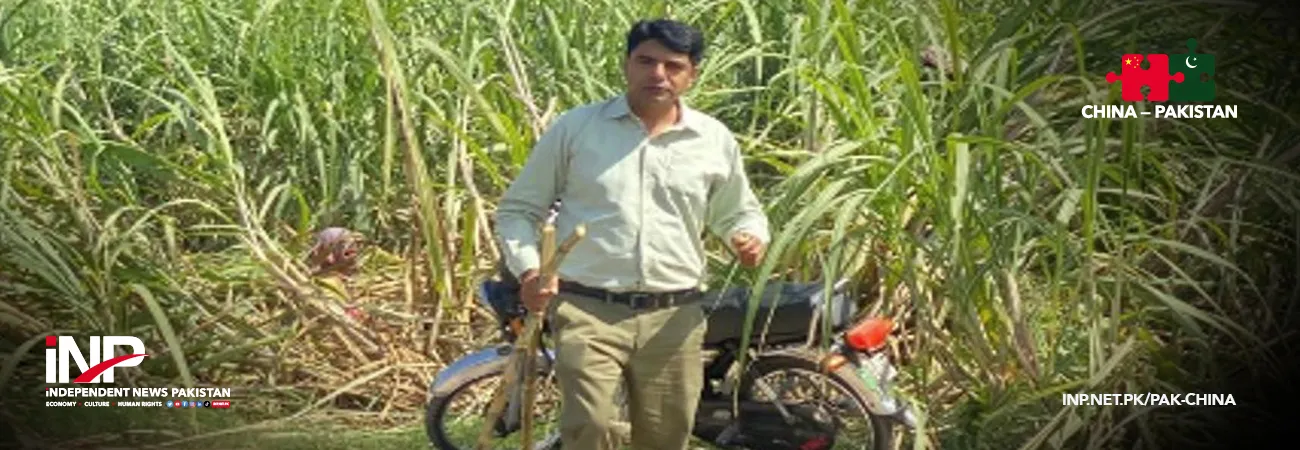i NEWS PAK-CHINA
Pak-China sugarcane cooperation edges ahead for bright future despite challenges, according to a report published by Gwadar Pro on Monday. The surge in sugar prices in Pakistan reflects a series of deep-rooted elements. Key factors contributing to this situation includes the increase in sugarcane production costs manipulation by domestic sugar “mafia” and a flawed subsidy system. Moreover, our entire sugarcane industry needs technological changes to bring about industrial upgrading and help reduce related costs. Dr. Fahd Rasul, Associate Professor of Agronomy, University of Agriculture Faisalabad (UAF) told Gwadar Pro that the highly volatile sugar price has jumped from 85 rupees/kg to 160-170 rupees/kg ahead of the crushing season start. Sugarcane production in 2021-22 based on official plantation areas of about 1.25 million hectares was about 88.6 million tons, a certain growth from the same period of last year (1.16 million ha/80.9 million tons). The unit output in 2021-22 (70.35 Tons/Ha) is almost the same as the previous year (69.55 Tons/Ha), according to Annual Report 2022 published by Pakistan Sugar Mills Association (PSMA).
However, Pakistan’s sugarcane yield per hectare is much lower than that of other major producers. In 2018 alone, the yield was 62 tons, far below the world average of 73 tons as well as India’s 80 tons. Sikandar Khan, a PSMA senior official, noted that in addition to artificial factors such as monopoly and market manipulation, the increase in sugarcane production costs such as fertilizers, pesticides and transportation is the main reasons for the soaring sugar prices. Sugarcane uses more subsidized agricultural inputs than other cash crops, especially fertilizers and water. In highly water-stressed countries, including Pakistan, sugarcane consumes much more water than any other cash crop. It is urgent to cultivate high-quality sugarcane varieties that consume less water, have higher sugar extraction efficiency, and are more resistant to pests and diseases. “The sugarcane industry in Pakistan is characterized by the cultivation of several key varieties, particularly in the Punjab region.
Among the notable varieties are CPF-248, CPF-249, CPF-250, CPF-251, and CPF-252, each with its own unique characteristics in terms of maturation period, yield, and resistance to diseases, in which CPF-248 has the highest sugar content at 12.71%; at the same time, it has good tillering potential, resist lodging, and thus suitable for regeneration,” Fahd Rasul elaborated. In addition, in order to better expand the global market, Pakistan should comprehensively improve the level of sugar industry to allow more domestic mills to obtain Bonsucro sugar certification, the leading global sustainability platform and standard for sugarcane. Currently only 3 mills are certified for Bonsucro. “While these varieties contribute significantly to our sugarcane industry, there is a recognized need for collaboration with China to further enhance production, technological adoption, and disease resistance,” Prof Rasul pointed out. “The recent think tank session at the Pakistan China Joint Chamber of Commerce and Industry (PCJCCI) highlighted the potential for cooperation in the sugarcane sector between the two countries.
Several bilateral discussions of our sugarcane research group and Guangzhou Sugar Industry Research Institute happened and an MoU was also in discussion. Hopefully it could be signed soon.” According to Rasul, the potential areas of cooperation include not only technology transfer like tissue culture and disease-free seedling, exchange of leading varieties from China, collaboration on integrated pest management strategies, training programs for Pakistani scientists and experts in collaboration with institutions like China's Academy of Tropical Agricultural Sciences (CATAS), but also modernization of Pakistan’s agriculture sector, aligning it with international standards by leveraging China's expertise. Pakistan’s subtropical climate is suitable for sugarcane growth. The sugarcane yield in some areas is similar to that of China, where average yield is 740 maunds per acre. Some advanced farmers with high cultivation level can harvest up to 2,000 maunds per acre, especially in Rahim yar khan, south Punjab. “Breeding facilities from China are desirable and varietal breeding programs can help enhance the sustainability of Pakistan’s sugarcane industry.” Regarding the extraction, the reporter was told that despite ranking as the 9th largest global sugar producer with a raw output of 4,881,225-ton, Pakistan’s susceptibility to world price fluctuations and the necessity to import sugar underscore the need for improvement.
“To tackle this, investments in technological upgrades within sugar mills are imperative, focusing on advanced machinery to optimize sugar extraction from sugarcane while minimizing waste,” Rasul added that machinery upgrade and worker training contain possible opportunities for Pakistan-China cooperation, echoed by the PCJCCI officials, including President Moazzam Ghurki and Vice President Hamza Khalid, both of whom emphasized the potential for a “sweet revolution” through collaborative efforts, envisioning a scenario where both nations, as “iron friends,” can export high-grade sugar to the global market. “On a deeper level, exploring diversification opportunities for sugarcane-derived products beyond sugar alone, such as ethanol, molasses, and bagasse and newer market sectors, from alcohol to biofuels and bioplastics, offers strategic avenues for market expansion. Cooperation with China in these aspects can gradually help Pakistan get rid of the backward situation of single industrial structure,” Rasul informed Gwadar Pro.
Credit: Independent News Pakistan (INP) — Pak-China









